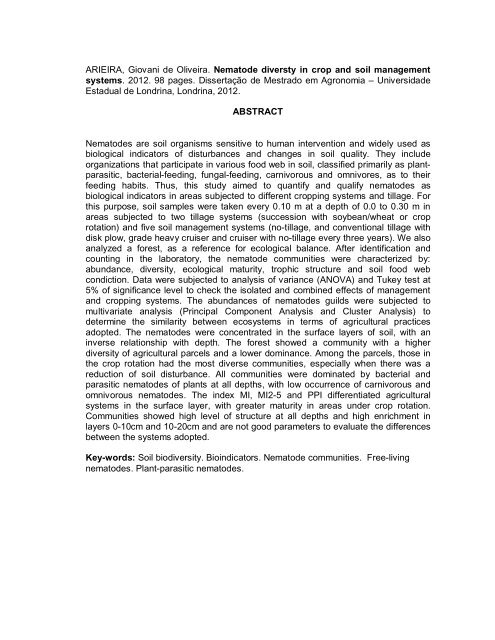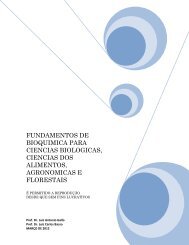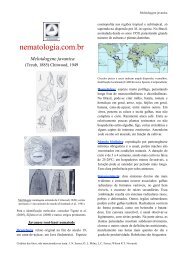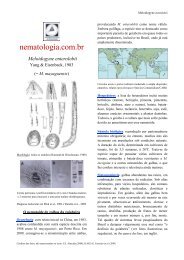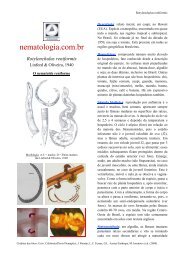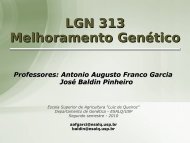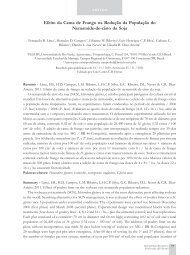diversidade de nematoides em sistemas de culturas e ... - Index of
diversidade de nematoides em sistemas de culturas e ... - Index of
diversidade de nematoides em sistemas de culturas e ... - Index of
Create successful ePaper yourself
Turn your PDF publications into a flip-book with our unique Google optimized e-Paper software.
ARIEIRA, Giovani <strong>de</strong> Oliveira. N<strong>em</strong>ato<strong>de</strong> diversty in crop and soil manag<strong>em</strong>entsyst<strong>em</strong>s. 2012. 98 pages. Dissertação <strong>de</strong> Mestrado <strong>em</strong> Agronomia – Universida<strong>de</strong>Estadual <strong>de</strong> Londrina, Londrina, 2012.ABSTRACTN<strong>em</strong>ato<strong>de</strong>s are soil organisms sensitive to human intervention and wi<strong>de</strong>ly used asbiological indicators <strong>of</strong> disturbances and changes in soil quality. They inclu<strong>de</strong>organizations that participate in various food web in soil, classified primarily as plantparasitic,bacterial-feeding, fungal-feeding, carnivorous and omnivores, as to theirfeeding habits. Thus, this study aimed to quantify and qualify n<strong>em</strong>ato<strong>de</strong>s asbiological indicators in areas subjected to different cropping syst<strong>em</strong>s and tillage. Forthis purpose, soil samples were taken every 0.10 m at a <strong>de</strong>pth <strong>of</strong> 0.0 to 0.30 m inareas subjected to two tillage syst<strong>em</strong>s (succession with soybean/wheat or croprotation) and five soil manag<strong>em</strong>ent syst<strong>em</strong>s (no-tillage, and conventional tillage withdisk plow, gra<strong>de</strong> heavy cruiser and cruiser with no-tillage every three years). We alsoanalyzed a forest, as a reference for ecological balance. After i<strong>de</strong>ntification andcounting in the laboratory, the n<strong>em</strong>ato<strong>de</strong> communities were characterized by:abundance, diversity, ecological maturity, trophic structure and soil food webcondiction. Data were subjected to analysis <strong>of</strong> variance (ANOVA) and Tukey test at5% <strong>of</strong> significance level to check the isolated and combined effects <strong>of</strong> manag<strong>em</strong>entand cropping syst<strong>em</strong>s. The abundances <strong>of</strong> n<strong>em</strong>ato<strong>de</strong>s guilds were subjected tomultivariate analysis (Principal Component Analysis and Cluster Analysis) to<strong>de</strong>termine the similarity between ecosyst<strong>em</strong>s in terms <strong>of</strong> agricultural practicesadopted. The n<strong>em</strong>ato<strong>de</strong>s were concentrated in the surface layers <strong>of</strong> soil, with aninverse relationship with <strong>de</strong>pth. The forest showed a community with a higherdiversity <strong>of</strong> agricultural parcels and a lower dominance. Among the parcels, those inthe crop rotation had the most diverse communities, especially when there was areduction <strong>of</strong> soil disturbance. All communities were dominated by bacterial andparasitic n<strong>em</strong>ato<strong>de</strong>s <strong>of</strong> plants at all <strong>de</strong>pths, with low occurrence <strong>of</strong> carnivorous andomnivorous n<strong>em</strong>ato<strong>de</strong>s. The in<strong>de</strong>x MI, MI2-5 and PPI differentiated agriculturalsyst<strong>em</strong>s in the surface layer, with greater maturity in areas un<strong>de</strong>r crop rotation.Communities showed high level <strong>of</strong> structure at all <strong>de</strong>pths and high enrichment inlayers 0-10cm and 10-20cm and are not good parameters to evaluate the differencesbetween the syst<strong>em</strong>s adopted.Key-words: Soil biodiversity. Bioindicators. N<strong>em</strong>ato<strong>de</strong> communities. Free-livingn<strong>em</strong>ato<strong>de</strong>s. Plant-parasitic n<strong>em</strong>ato<strong>de</strong>s.


